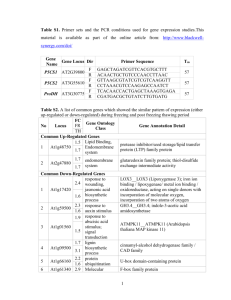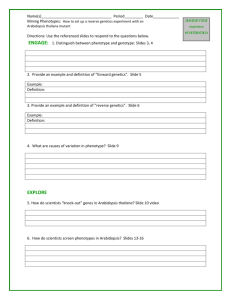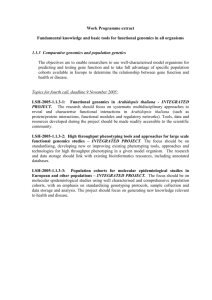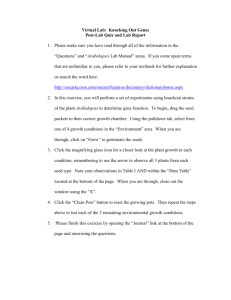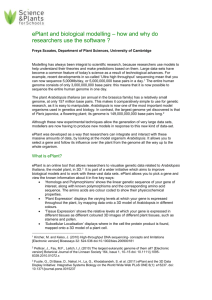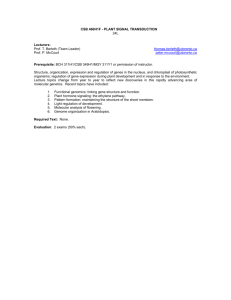Sample solutions to the tutorial.
advertisement
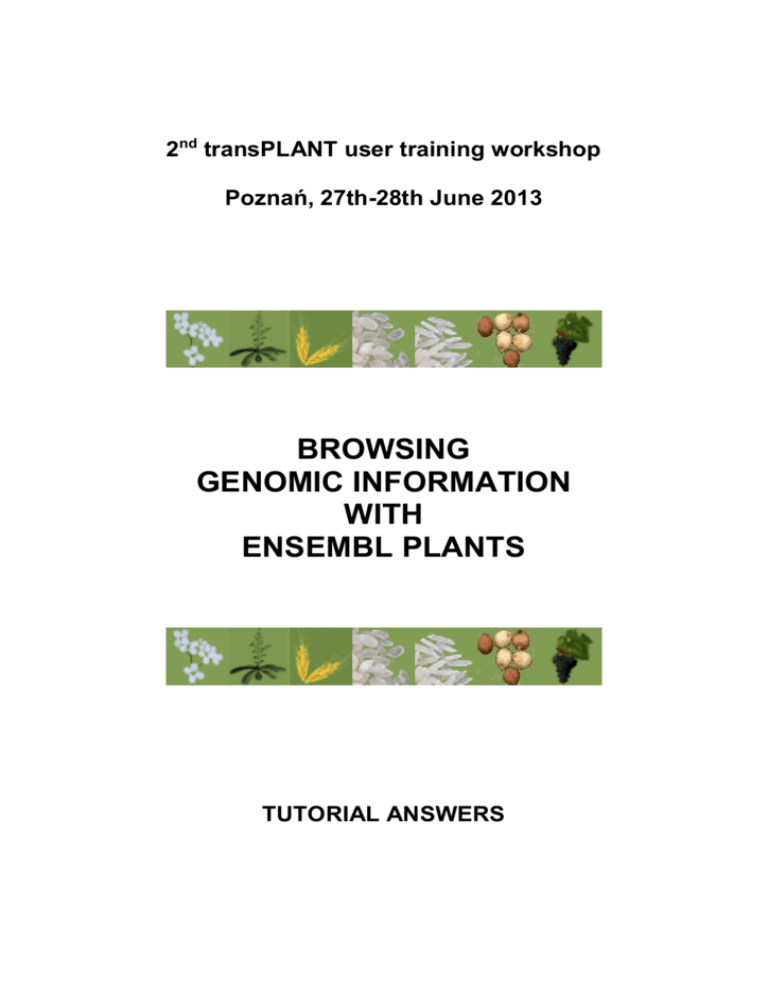
2nd transPLANT user training workshop Poznań, 27th-28th June 2013 BROWSING GENOMIC INFORMATION WITH ENSEMBL PLANTS TUTORIAL ANSWERS Exercise 1 Go to the Ensembl Plants homepage (http://plants.ensembl.org). The current release (version) of Ensembl Plants is 18 (April 2013). Click on the picture of Arabidopsis thaliana or on the word ‘Arabidopsis thaliana’ next to it. The genome sequence and gene annotation for Arabidopsis thaliana are based on data from version 10 of The Arabidopsis Information Resource (TAIR; http://www.arabidopsis.org) database, released in November 2010. Exercise 2 Type ‘glucose-6-phosphate dehydrogenase 1’ in the Search box. Click [Go]. Click on ‘G6PD1 [AT5G35790]’. The official gene name for this gene, from TAIR, is ‘G6PD1’. It is located on chromosome 5, on the reverse strand. Click [he!p]. The empty boxes, filled boxes and lines in the transcript models represent the UTRs (UnTranslated Regions), CDS (CoDing Sequence) and introns, respectively. Exercise 3 Click on ‘Plant Compara - Paralogues’ in the side menu. There have been five paralogues identified for the G6PD1 gene. G6PD2 (AT5G13110) and G6PD3 (AT1G24280) show the highest Target %id and Query %id. Glucose-6-phosphate dehydrogenase 2 and 3 thus have the highest sequence similarity to glucose-6-phosphate dehydrogenase 1 (Target %id indicates the percentage of the sequence of glucose-6-phosphate dehydrogenase 1 matching the sequence of the paralogous protein. Query %id indicates the percentage of the sequence of the paralogous protein matching the sequence of glucose-6-phosphate dehydrogenase 1). Click on ‘Plant Compara -Gene Tree (image)’ in the side menu. Click on ‘View option - View paralogs of current gene’ below the Gene Tree display. Click on the various duplication nodes (shown in red) and have a look at the resulting pop-ups. A duplication event on the level of the Magnoliaphyta (flowering plants) has given rise to the G6PD1 gene and the ancestor of the G6PD2 and G6PD3 genes. The other paralogues are due to earlier duplication events. This agrees with the fact that glucose-6-phosphate dehydrogenase 2 and 3 show the highest sequence similarity with glucose-6-phosphate dehydrogenase 1, as seen on the ‘Paralogues’ page. The G6PD2 and G6PD3 genes themselves are the result of a more recent duplication at the level of the Brassicaceae (crucifers). Click on ‘Pan-taxonomic Compara -Gene Tree (image)’ in the side menu. Yes, according to the pan-taxonomic gene tree, glucose-6-phosphate dehydrogenase is present in species across all kingdoms, from E. coli to human. This is not surprising, as it is part of a crucial metabolic pathway. Exercise 4 Click on the ‘Transcript: AT5G35790.1’ tab. The transcript has eight exons. Both the first and the last exon are partially untranslated, as can be seen from the partially open (and narrower) boxes at the 5’ and 3’ ends. The nucleotide sequence of the transcript is shown on the ‘Sequence - Exons’ page. On this page the UTRs are shown in purple, and the CDS, introns and flanking sequences in black, blue and green, respectively. Click on ‘External References – General identifiers’ in the side menu. Yes, AT5G35790.1 is cross-referenced to the UniProtKB/Swiss-Prot database. Click on ‘G6PD1_ARATH’. The UniProtKB/Swiss-Prot ID for the cross-referenced protein is ‘Q43727 (G6PD1_ARATH)’ and the recommended name ‘Glucose-6-phosphate 1dehydrogenase 1, chloroplastic’. Click on the various ‘Ontology’ links in the side menu. Yes, the ‘biological process’ GO term ‘pentose-phosphate shunt, oxidative branch’ hints at a role of glucose-6-phosphate dehydrogenase 1 in the pentose phosphate pathway. The definition of this term, according to QuickGo (http://www.ebi.ac.uk/QuickGO/GTerm?id=GO:0009051), is ‘The branch of the pentose-phosphate shunt which involves the oxidation of glucose 6-P and produces ribulose 5-P, reduced NADP+ and carbon dioxide (CO2).’ According to the ‘cellular component’ GO term, glucose-6-phosphate dehydrogenase 1 is located in the chloroplast. Click on ‘Protein Information – Protein summary’. … or … Click on ‘Protein Information – Domains & features’ in the side menu. The NAD binding domain (G6P_DH_NAD_bd) is located in the N-terminal half of the glucose-6-phosphate dehydrogenase 1 protein. The domain information is imported from the Pfam database (http://pfam.sanger.ac.uk/family/PF00479). Exercise 5 Click on the ‘Location: 5:13,956,690-13,959,753’ tab. Click [Configure this page] in the side menu. Click on ‘Comparative genomics – BLASTz/LASTz alignments’. Click on ‘Enable/disable all BLASTz/LASTz alignments’. Select ‘Compact’. Click (). New tracks should have been added to the display showing in pink for each species in Ensembl Plants the sequence from Arabidopsis thaliana that could be aligned to the genome of the species in question for this region. The highest conservation is found between Arabidopsis thaliana and Arabidopsis lyrata, and the lowest conservation between Arabidopsis thaliana and Chlamydomonas reinhardtii and Cyanidioschyzon merolae. This is not surprising given that fact that Arabidopsis lyrata is the species most closely related to Arabidopsis thaliana, while Chlamydomonas reinhardtii and Cyanidioschyzon merolae are the least related. Across all species the sequence of the CDS is the most conserved, while the sequence of the UTRs, introns and intergenic sequence is less conserved or not conserved at all. This is what one would expect as CDS are supposed to be under higher selection pressure than UTRs, intronic and intergenic sequences. Exercise 6 Click [Manage your data] in the side menu. Click on ‘Attach Remote File’. Enter the URL of the file in the ‘File URL’ text box (http://www.ebi.ac.uk/~bert/SRR070570.bam). Select ‘Data format: BAM’. Enter ‘SRR070570’ in the ‘Name for this track’ text box. Click [Next>]. Click (). A new track, named ‘SRR070570’, should now have been added to the display. The track shows the coverage as well as the actual reads. Yes, the G6PD1 gene is expressed. Zoom in to see the actual reads. Individual reads are shown in grey, with the consensus sequence shown above the reads in colour. Nucleotides that differ from the sequence of the reference genome are shown in red. For example: http://plants.ensembl.org/Arabidopsis_thaliana/Location/View?db=core&r=5% 3A13957459-13957508 Type ‘RBCS1A’ in the ‘Gene:’ text box. Click [Go]. The RBCS1A gene is much higher expressed than the G6PD1 gene. Type ‘PR1’ in the ‘Gene:’ text box. Click [Go]. The PR1 gene is not expressed at all. Exercise 7 Click on the ‘Tools’ link on the toolbar. Click on ‘Variant Effect Predictor - Upload your data’. Select ‘Species: Arabidopsis thaliana: TAIR10’. Enter ‘New variants’ in the ‘Name for this upload (optional)’ text box. Enter the file URL in the ‘or provide file URL:’ text box (http://www.ebi.ac.uk/~bert/athaliana_g6pd1_new_variants.txt). Click [Next>]. Click on ‘HTML’. Note that the results show the effects of the variants on the G6PD1 gene (AT5G35790) as well as three genes that are closely located to it, i.e. AT5G35777, AT5G35780 and AT5G35791. Twelve variants are non-synonymous coding in the G6PD1 (AT5G35790) gene and thus cause an amino acid change. Three variants have already been annotated by Ensembl as can be seen from the accession numbers that are shown in the ‘Co-located Variation’ column (ENSVATH07217576, ENSVATH11967650 and ENSVATH11967739). Click on the ‘Location’ column of the ‘Variant Effect Predictor Results’ page for one of the variants. The uploaded variants should be shown on the ‘Region in detail’ page in a new track, named ‘New variants’. The ‘Sequence variants (all sources)’ track should also be added to allow comparison with the new variants. Exercise 8 Click the ‘BioMart’ link on the toolbar. Choose the ‘Ensembl Plants Genes 18’ database. Choose the ‘Arabidopsis thaliana genes (TAIR10)’ dataset. Click on ‘Filters’ in the left panel. Expand the ‘GENE ONTOLOGY section by clicking on the + box. Enter ‘pentose –phosphate shunt’ in the ‘GO Term Name’ text box. Make sure the check box in front of the filter is ticked, otherwise the filter won’t work. Click the [Count] button on the toolbar. Click on ‘Attributes’ in the left panel. Expand the ‘GENE’ section by clicking on the + box. Deselect ‘Ensembl Transcript ID’. Select ‘Associated Gene Name’ and ‘Description’. Select ‘Export all results to File – XLS’. Check ‘Unique results only’. Click [Go]. … or … Click the [Results] button on the toolbar. Select ‘View All rows as HTML. Check ‘Unique results only’. The query should give you 25 out of a total of 33602 genes. Apart from G6PD4, which apparently hasn’t been annotated with this GO term, all G6PD genes are amongst the results.
